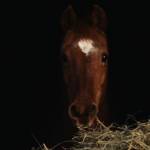Feeding Horses: Effects on Human and Equine Respiratory Health

Mold spores and organic dust are an important cause and aggravator of respiratory disease in both humans and horses. Working with horses has been recognized as a potential respiratory hazard since the 1700s. Potential allergens and respiratory irritants encountered by humans in normal contact with horses include horse dander, dust, grain mites, powdered feed supplements, mold, fungal spores, and endotoxins (potent toxins produced by certain types of common gut bacteria).
Researchers in New Zealand investigated the respiratory health of horse trainers.1 Among the horse trainers who responded to the survey, few reported using breathing protection. The risk of having signs of bronchitis was increased 2.3 times among male horse trainers who worked 40 hours or more per week training horses. Another strong risk factor was mixing powdered supplements into horse feed, which also increased the risk of bronchitis 2.3 times. Spreading out hay almost doubled (1.9 times) the chance of horse trainers having signs of “farmer’s lung” (organic dust toxic syndrome). Interestingly, cleaning stalls, cutting chaff (hay), and bedding type were not significantly associated with an increased risk of respiratory disease.
Even good-quality hay contains mold spores and dust, and the best ventilated barn is full of dust compared to an outside paddock. For these reasons, the respiratory tracts of horses kept in stalls are constantly assaulted by inhaled irritants and potential allergens. Environmental management is essential to control allergic airway diseases such as heaves and inflammatory airway disease (IAD), and no treatments will be as successful without changing the horse’s environment. Ideally, horses affected with heaves or IAD should be kept outside at all times. An effective method used to produce clinical signs of heaves in an affected horse is to bring the horse into a stall from pasture and bed its stall with straw.
Humans with allergic respiratory disease should consult a physician for the best advice. The study above pointed out that many equine caretakers do not wear breathing protection such as facemasks when working in dusty environments, which would be an important first step to avoiding problems.
Supplements can be made less dusty by mixing them into molasses or sweet feeds that contain molasses. The molasses binds the “fines” or dust. The addition of water, liquid supplements, or yogurt is also helpful to reduce exposure of dust to both the caretaker and the horse.
Soaking hay can be messy and problematic, but will decrease the amount of dust in the hay. Commercial hay steamers are now available that effectively reduce the quantity of mold spores. Feeding hay on the ground limits the amount of dust particles and mold spores that the horse breathes while eating by naturally allowing the horse to clear mucus and inhaled particles from its respiratory tract and preventing any saliva or feed material from entering the trachea (windpipe). Storing hay in barn lofts increases and constantly exposes horses to dust and mold spores from hay.
Instead of straw, horses can be bedded on wood shavings, cardboard, or paper bedding, which has been shown to greatly reduce dust in the stall environment.
Both humans and horses are exposed to large amounts of potential respiratory tract irritants in their normal environments and this exposure is even greater in a barn. It is important for humans to realize that exposure to inhaled irritants is nearly constant for them and their horses. Reducing this exposure will improve respiratory health for both horses and their caretakers.
1Gallagher, L.M., J. Crane, P. Fitzharris, and M.N. Bates. 2007. Occupational respiratory health of New Zealand horse trainers. International Archives of Occupational and Environmental Health 80:335-341.








